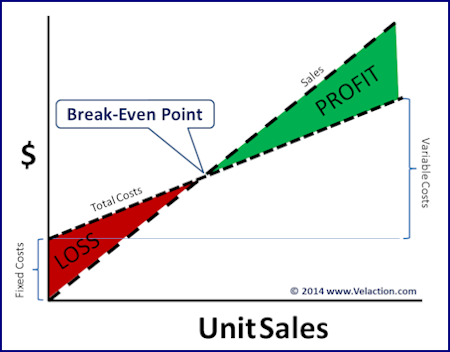Value-Added Work
Value added work consists of the tasks that a customer is willing to pay for. Generally this is something that changes the form, fit, or function of raw materials. Note that it is very important to consider value from the customer perspective. In some cases, they will value something that Read more…
Work Sequence
The work sequence is, not surprisingly, the order in which tasks are completed. Work sequence is also commonly referred to as the sequence of operations. Many tasks follow a logical order. Consider the assembly of a go kart. It makes sense that the tires are installed onto the wheels before Read more…
Yield
Yield is a quality ratio. It is calculated by dividing the number of good pieces of work by the number of pieces of work started and is expressed as a percent. If a process starts work on 100 items, for example, and 92 make it off the end of the Read more…
Break-Even Point
The break-even point is the point (number of units sold) where the company can “break-even” and start earning profit. When a product or service is sold to a customer, the company incurs both fixed and variable costs. Fixed costs are the same regardless of the number of units sold. Variable Read more…
Off the Shelf
The tools, machines, software, or other resources you use to do your job fall into two basic categories. The first type is the most common and contains “off the shelf” resources. The second category includes custom built or highly modified tools, equipment, or even software. Off the shelf items tend Read more…
Delivery
Delivery is one of the legs of the QDC (quality, cost, delivery) acronym. It is a very simple concept—to get paid, you have to get your product to your customer. For such a simple concept, delivery plays a large role in a company’s performance. Doing well at delivering quickly can Read more…
Backflush
Backflushing is an accounting method that applies costs to production but can also be used to manage inventory. It is also known as “postproduction issuing.” When an operation is completed, the appropriate materials and other resources are issued against the production order. The inventory levels in the system of all Read more…
Obsolescence
Any product or service you purchase has a useful life. After that, the value of continuing to use it declines until it makes sense to move to something more modern. The most common example of this is computers. Software becomes outdated at a regular pace as new hardware is developed. Read more…
Dedicated Equipment
Dedicated pieces of equipment are machines and tools that are specified for specific tasks or workstations. The primary purpose of dedicating equipment to a specific process step is to facilitate flow. If a machine is shared, it may not be available when needed, causing items to wait in a queue. Read more…

